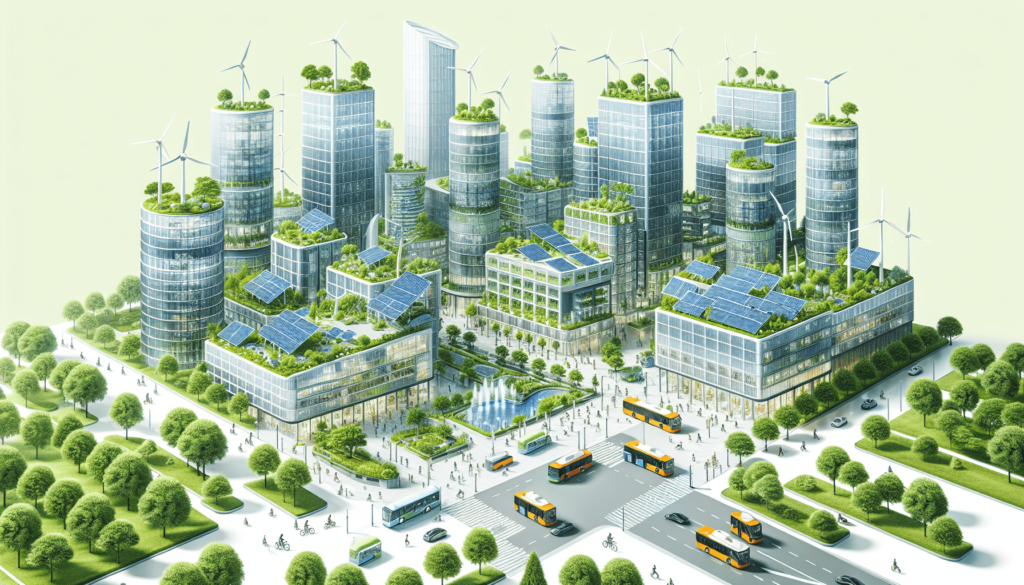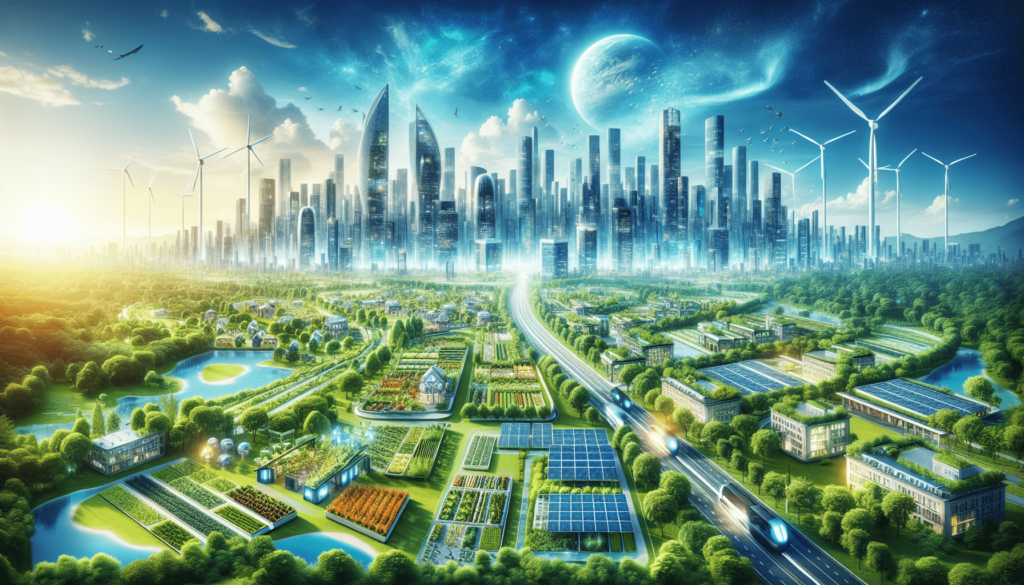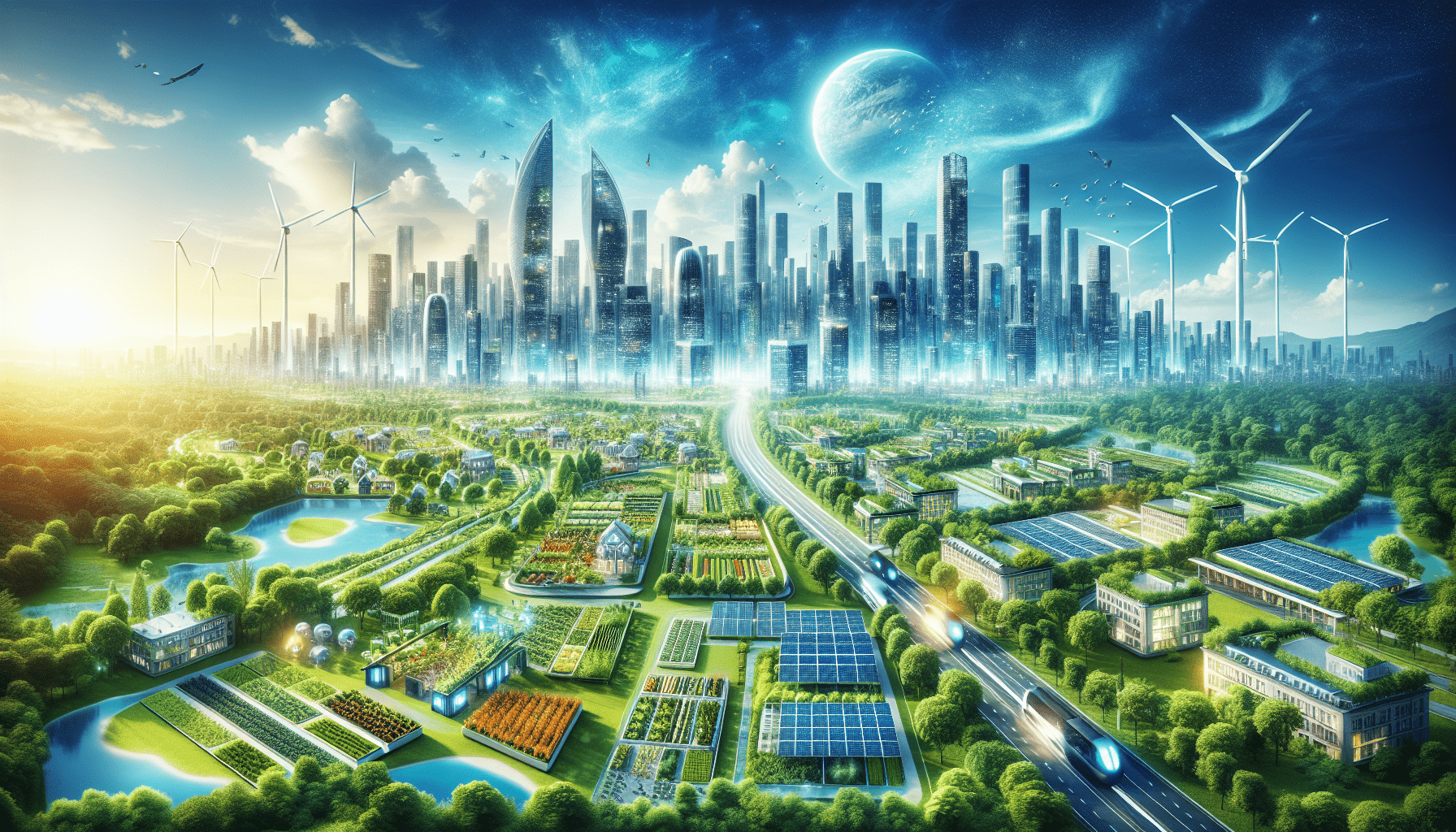In today’s ever-growing urban landscape, it has become imperative to address the challenges of building sustainable cities. One crucial factor that plays a pivotal role in this process is green technology. From renewable energy sources to eco-friendly infrastructure, green technology not only reduces the carbon footprint but also fosters a harmonious coexistence between human development and environmental preservation. This article explores the indispensable role of green technology in building sustainable cities, highlighting the numerous benefits it brings to our communities and the planet as a whole.
Enhancing Energy Efficiency
Implementation of Smart Grid Systems
Implementing smart grid systems is a key step towards enhancing energy efficiency in cities. Smart grids are intelligent electricity networks that utilize advanced technology to monitor and manage the flow of electricity. By integrating renewable energy sources, energy storage systems, and demand response programs, smart grids can optimize energy usage, reduce peak demand, and minimize energy losses. These systems enable efficient distribution and utilization of electricity, leading to significant energy savings and cost reductions for both the consumers and the utility companies.
Energy-efficient Buildings
Energy-efficient buildings play a crucial role in reducing energy consumption and promoting sustainability in cities. By utilizing innovative technologies and design strategies, these buildings can significantly minimize energy requirements for heating, cooling, and lighting. Features such as high-quality insulation, energy-efficient appliances, smart lighting systems, and smart climate control systems can greatly reduce energy consumption. Additionally, incorporating renewable energy systems, such as solar panels or wind turbines, into building designs further enhances their overall energy efficiency.
Renewable Energy Sources
Integrating renewable energy sources into the energy mix of cities is essential for building sustainable communities. Solar, wind, hydro, and geothermal energy can provide clean and abundant power, reducing dependency on fossil fuels and minimizing greenhouse gas emissions. Installing solar panels on rooftops, utilizing wind turbines in open areas, and tapping into hydroelectric or geothermal resources can contribute to a greener and more sustainable energy generation. Embracing renewable energy sources is not only environmentally friendly but also economically advantageous in the long run.
Intelligent Transportation Systems
Intelligent transportation systems (ITS) offer opportunities to enhance energy efficiency and reduce emissions in urban areas. These systems utilize advanced technologies, such as real-time traffic monitoring, smart traffic signals, and vehicle-to-infrastructure communication, to optimize traffic flow and reduce congestion. By minimizing idling time and improving traffic efficiency, ITS helps to reduce fuel consumption and emissions from vehicles. Additionally, the integration of electric vehicles (EVs) into the transportation network promotes further energy efficiency and emissions reductions. Charging stations and incentives for EV adoption encourage the use of clean and sustainable transportation options.
Promoting Waste Management
Waste Reduction and Recycling Programs
Implementing waste reduction and recycling programs is crucial for sustainable waste management in cities. By educating and encouraging individuals and businesses to reduce waste generation and properly separate recyclables, significant amounts of waste can be diverted from landfills. This not only conserves natural resources but also reduces greenhouse gas emissions associated with waste disposal. Implementing comprehensive recycling infrastructure and providing convenient collection services can further promote recycling and contribute to the circular economy.
Advanced Waste Treatment Technologies
Advanced waste treatment technologies offer efficient and sustainable alternatives to traditional waste management practices. Technologies such as anaerobic digestion, composting, and waste-to-energy processes enable the conversion of organic waste materials into valuable resources, such as biogas or fertilizer. These innovative approaches not only reduce the volume of waste sent to landfills but also produce renewable energy or useful byproducts. Implementing these technologies in cities can help achieve waste reduction targets while simultaneously generating economic benefits.
Implementing Circular Economy Principles
Incorporating circular economy principles into waste management practices is critical for achieving sustainability in cities. The concept of a circular economy aims to minimize waste generation by maximizing the reuse, recycling, and recovery of materials. By promoting practices such as repairing, repurposing, and refurbishing, cities can reduce the demand for new resources and minimize environmental impacts associated with resource extraction and manufacturing. Embracing a circular economy approach not only benefits the environment but also fosters innovation, job creation, and economic growth.

Conserving Water Resources
Water-saving Technologies in Buildings
Utilizing water-saving technologies in buildings is essential for conserving water resources in urban areas. These technologies include low-flow fixtures, such as water-efficient toilets, faucets, and showerheads, as well as water-saving appliances, such as efficient dishwashers and washing machines. Implementing greywater recycling systems and rainwater harvesting techniques can also contribute to water conservation efforts. By adopting these technologies, cities can reduce water consumption, alleviate strain on water supplies, and preserve this precious resource for future generations.
Smart Irrigation Systems
Smart irrigation systems offer an intelligent and efficient approach to watering landscapes and maintaining green spaces in cities. These systems utilize sensors, weather data, and real-time information to optimize watering schedules and ensure that water is used only when and where needed. By avoiding overwatering and minimizing evaporation losses, smart irrigation systems can significantly reduce water wastage. Furthermore, the integration of soil moisture sensors and automatic shut-off valves further enhances the efficiency and effectiveness of these systems.
Rainwater Harvesting and Utilization
Rainwater harvesting is an effective technique for conserving water resources and reducing reliance on mains water supply. By collecting and storing rainwater from rooftops, this resource can be used for various non-potable purposes, such as irrigation, toilet flushing, and washing. Rainwater harvesting systems can be tailored to various scales, from individual households to large-scale commercial and institutional buildings. Implementing rainwater harvesting practices in cities helps to reduce pressure on freshwater sources and contributes to overall water sustainability efforts.
Improving Air Quality
Encouraging Alternative Modes of Transportation
Encouraging the use of alternative modes of transportation can significantly improve air quality in cities. Promoting walking, cycling, and the use of public transportation reduces the number of vehicles on the road and decreases emissions from fossil fuel combustion. Enhancing infrastructure for pedestrians and cyclists, such as dedicated paths, bike lanes, and safe crossings, encourages the adoption of these sustainable modes of transport. Furthermore, providing comprehensive and efficient public transportation systems, including buses, trams, and trains, incentivizes people to choose greener and cleaner commuting options.
Low or Zero Emission Vehicles
The deployment of low or zero emission vehicles is crucial for reducing air pollution in cities. Electric vehicles (EVs), powered by electricity stored in batteries or fuel cells, produce zero tailpipe emissions and have significantly lower overall emissions compared to conventional internal combustion engine vehicles. Encouraging the adoption of EVs through incentives, subsidies, and the development of charging infrastructure contributes to cleaner and healthier urban environments. Additionally, supporting the use of other low-emission vehicles, such as hydrogen fuel cell vehicles and hybrid vehicles, further promotes air quality improvements.
Air Pollution Monitoring and Control Systems
Implementing air pollution monitoring and control systems is essential for addressing air quality issues in cities. These systems utilize sensors and real-time data to monitor air pollution levels and identify sources of emissions. By pinpointing areas with poor air quality, cities can take targeted actions to mitigate pollution, such as implementing traffic management strategies, establishing emission control regulations, or optimizing industrial processes. Additionally, public awareness of air quality issues can be raised through information campaigns and access to real-time air quality data, empowering individuals to make informed choices regarding their activities and travel routes.

Creating Green Infrastructure
Green Roofs and Vertical Gardens
Green roofs and vertical gardens are effective strategies for creating green infrastructure in cities. Green roofs involve the installation of vegetation on rooftops, providing numerous benefits such as insulation, stormwater management, and improved air quality. Vertical gardens, also known as living walls or green walls, utilize vegetation on vertical surfaces, enhancing aesthetics, reducing heat island effects, and increasing biodiversity. These green infrastructure elements not only contribute to a healthier and more sustainable urban environment but also create pleasant spaces for residents and wildlife.
Urban Parks and Green Spaces
Urban parks and green spaces are essential components of sustainable cities. These areas provide numerous ecosystem services, such as carbon sequestration, stormwater management, and temperature regulation. Urban parks also promote physical and mental well-being by offering recreational opportunities, reducing stress, and fostering community interactions. Creating and preserving urban parks and green spaces not only enhances the quality of life for city dwellers but also contributes to the overall sustainability and resilience of urban ecosystems.
Bicycle and Pedestrian Infrastructure
Developing robust bicycle and pedestrian infrastructure is vital for creating sustainable and accessible urban environments. Designing and maintaining dedicated bike paths, walkways, and pedestrian-friendly zones encourage non-motorized modes of transport, reducing traffic congestion and emissions. Bicycle-sharing programs and bike-friendly policies further promote cycling as a viable transportation option. Investing in pedestrian infrastructure, such as well-designed sidewalks, pedestrian crossings, and pedestrian-only zones, prioritizes the safety and accessibility of pedestrians, making cities more inclusive and livable.
Developing Sustainable Construction Practices
Use of Environmentally Friendly Materials
Using environmentally friendly materials in construction is essential for sustainable cities. High-performance and low-impact building materials, such as recycled materials, sustainably sourced wood, or eco-friendly alternatives to traditional materials, minimize the environmental footprint of construction projects. Additionally, incorporating energy-efficient and non-toxic materials, such as insulation with a high thermal performance or low-VOC paints, improves building efficiency and indoor air quality. Adopting sustainable material choices in construction helps to reduce resource depletion, waste generation, and environmental impacts.
Adoption of Green Building Certifications
The adoption of green building certifications, such as LEED (Leadership in Energy and Environmental Design) or BREEAM (Building Research Establishment Environmental Assessment Method), promotes sustainable construction practices in cities. These certification systems assess and recognize buildings that meet specific sustainability criteria, including energy efficiency, water conservation, materials selection, and indoor environmental quality. By encouraging the use of environmentally responsible design and construction practices, green building certifications drive the development of sustainable and resource-efficient buildings.
Incorporation of Energy-efficient Designs
Incorporating energy-efficient designs into buildings is a fundamental aspect of sustainable construction practices. Passive design strategies, such as optimizing building orientation, maximizing natural daylighting, and utilizing natural ventilation, reduce the need for artificial lighting, heating, and cooling. Additionally, energy-efficient technologies, including efficient HVAC systems, smart lighting controls, and energy management systems, further enhance building performance. By prioritizing energy efficiency in building design, cities can reduce energy consumption, lower carbon emissions, and achieve significant energy savings.
Encouraging Sustainable Mobility
Promotion of Public Transportation
Promoting public transportation is key to encouraging sustainable mobility in cities. Developing comprehensive, reliable, and efficient public transportation networks, including buses, trams, and trains, provides people with a viable alternative to private car use. Offering incentives, such as affordable fares, integrated ticketing systems, and improved connectivity, makes public transportation more attractive and accessible. By increasing public transportation ridership, cities can reduce traffic congestion, lower emissions, and improve air quality while providing equitable transportation options for all residents.
Implementation of Bike-sharing Programs
Implementing bike-sharing programs encourages sustainable mobility and reduces reliance on motorized transportation. These programs provide access to bicycles for short-distance trips, reducing the need for private car use. By establishing bike-sharing stations in strategic locations and ensuring a sufficient number of bikes, cities can promote cycling as a convenient and environmentally friendly mode of transport. Supporting bike-sharing programs with infrastructure, such as bike lanes, secure parking facilities, and maintenance services, further enhances the adoption of this sustainable transportation option.
Walkability and Accessibility
Creating walkable and accessible urban environments is crucial for promoting sustainable mobility. Designing streetscapes that prioritize pedestrians, with features such as wide sidewalks, safe crossings, and well-lit pathways, encourages people to walk and reduces the reliance on cars for short trips. Additionally, fostering accessibility for individuals with disabilities and providing amenities such as benches and shade structures further enhances the walking experience. By prioritizing walkability and accessibility, cities can improve the overall livability, health, and sustainability of urban areas.
Fostering Community Engagement
Educational Programs on Sustainability
Educational programs on sustainability play a vital role in fostering community engagement and promoting sustainable practices in cities. By providing residents with knowledge and skills on sustainable living, waste management, energy efficiency, and other related topics, individuals are empowered to make informed decisions and take action. These programs can take various forms, including workshops, training sessions, awareness campaigns, and educational materials. Fostering a culture of sustainability through education encourages active participation and engagement from the community.
Collaborative Decision-making
Collaborative decision-making processes involve engaging various stakeholders, including community members, businesses, and local authorities, in the planning and implementation of sustainability initiatives. By involving different perspectives and expertise, decisions can be made collectively, ensuring that the needs and aspirations of the community are considered. This collaborative approach also strengthens community relationships, builds trust, and fosters a sense of ownership in sustainability projects. Effective communication and transparent processes are key to successful collaborative decision-making.
Engaging Citizens in Green Initiatives
Engaging citizens in green initiatives is essential for building sustainable cities. By involving residents in activities such as community gardens, tree planting, or neighborhood clean-ups, individuals develop a sense of connection and responsibility towards their environment. Citizen engagement can also take the form of participatory budgeting, where community members contribute to decisions on the allocation of resources for sustainability projects. Fostering citizen involvement and providing platforms for participation strengthens community bonds and creates a shared commitment to sustainability goals.
Harnessing Data and Technology
Smart City Platforms for Monitoring and Optimization
Smart city platforms provide the foundation for data collection, analysis, and optimization of various urban systems. By integrating data from sensors, devices, and networks, these platforms enable real-time monitoring and management of energy, water, transportation, and other critical infrastructure. The insights gained from these platforms can inform decision-making processes, optimize resource allocation, and improve operational efficiency. Harnessing the power of data and technology through smart city platforms enhances sustainability and resilience in cities.
Data-driven Decision-making
Data-driven decision-making is crucial for effective and targeted sustainability initiatives in cities. By analyzing data on energy consumption, water usage, waste generation, and other relevant metrics, cities can identify trends, set targets, and track progress towards sustainability goals. Advanced analytics tools and modeling techniques enable cities to forecast scenarios, evaluate the impact of interventions, and optimize resource allocation. Implementing data-driven decision-making processes ensures evidence-based and impactful actions for building sustainable cities.
Internet of Things (IoT) for Resource Management
The Internet of Things (IoT) presents opportunities for efficient resource management in cities. IoT devices, such as smart meters, environmental sensors, and connected infrastructure, allow for real-time monitoring and control of energy, water, and waste systems. By collecting and analyzing data from these devices, cities can identify inefficiencies, detect anomalies, and optimize resource utilization. IoT-based solutions enable remote monitoring, predictive maintenance, and automation, contributing to improved resource efficiency and sustainability in cities.
Planning for Climate Resilience
Adaptation Strategies for Extreme Weather
Planning for climate resilience involves developing strategies to adapt to extreme weather events, such as heatwaves, floods, or storms, resulting from climate change. Cities need to identify vulnerable areas, assess risks, and implement appropriate measures to protect infrastructure, ecosystems, and communities from the impacts of extreme weather. These strategies may include land use planning, flood mitigation measures, improved building standards, and the preservation of natural buffers. By planning for climate resilience, cities can minimize damages and disruptions, safeguarding the well-being and sustainability of urban environments.
Urban Heat Island Mitigation
Urban heat islands refer to areas in cities that experience significantly higher temperatures compared to surrounding rural areas due to human activities and the built environment. Mitigating urban heat islands is essential for maintaining comfortable and livable urban environments, especially during heatwaves or periods of extreme heat. Strategies such as designing green roofs and vertical gardens, increasing tree canopy cover, incorporating cool materials in construction, and optimizing urban layout to enhance natural ventilation can effectively reduce surface and air temperatures, reducing the heat island effect and improving urban comfort.
Green Infrastructure for Climate Resilience
Green infrastructure, including parks, green spaces, and urban forests, plays a critical role in building climate resilience in cities. By enhancing natural ecosystems within urban areas, green infrastructure helps to regulate temperature, manage stormwater, and improve air quality. Well-designed green spaces also provide recreational opportunities, promote biodiversity, and enhance overall livability. Incorporating green infrastructure into urban planning and development ensures that cities are more resilient to the impacts of climate change, while simultaneously creating attractive and sustainable urban environments.
In conclusion, building sustainable cities requires comprehensive efforts in various aspects of urban planning, design, and management. Enhancing energy efficiency, promoting waste management, conserving water resources, improving air quality, creating green infrastructure, developing sustainable construction practices, encouraging sustainable mobility, fostering community engagement, harnessing data and technology, and planning for climate resilience are all essential components of sustainable city development. By implementing these strategies and working collectively towards a sustainable future, cities can create livable, resilient, and environmentally friendly urban environments for generations to come.

